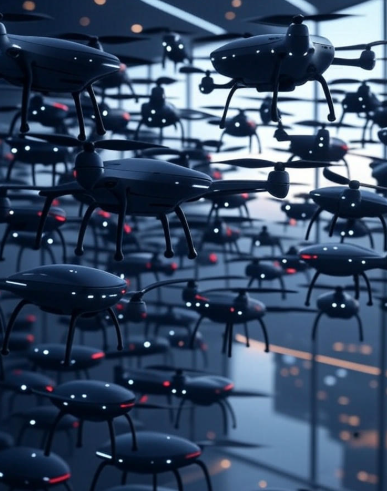As of April 8, 2025, the intersection of artificial intelligence (AI) and urban development is ushering in a transformative era for cities worldwide. Spatial AI—a cutting-edge branch of AI that leverages spatial data, such as 3D mapping, geospatial analytics, and real-time sensor inputs—is at the heart of this revolution. When paired with the concept of smart cities, which aim to enhance urban living through technology, Spatial AI promises to optimize infrastructure, improve sustainability, and elevate the quality of life for millions. From traffic management to environmental monitoring, the potential applications are vast and exciting. Let’s explore how Spatial AI is shaping the future of smart cities and what this means for urban dwellers and policymakers alike.
What is Spatial AI?
Spatial AI refers to the ability of AI systems to understand, interpret, and interact with the physical world using spatial data. Unlike traditional AI, which often relies on abstract data like text or numbers, Spatial AI integrates information from cameras, LiDAR, GPS, IoT sensors, and other spatial technologies to create a detailed, three-dimensional understanding of environments. This includes everything from the layout of a city block to the movement of people and vehicles in real time.
The technology builds on advancements in computer vision, machine learning, and robotics, enabling systems to “see” and “reason” about space. For instance, a Spatial AI model can analyze a city’s traffic patterns by processing data from traffic cameras and predicting congestion hotspots, or it can map underground utility lines to prevent construction mishaps. This spatial awareness makes it an ideal tool for the complex, dynamic ecosystems of modern cities.
The Rise of Smart Cities
Smart cities are urban areas that use technology and data to improve efficiency, sustainability, and livability. Powered by IoT devices, big data analytics, and now Spatial AI, these cities aim to address challenges like population growth, pollution, and resource scarcity. Examples include Singapore, with its real-time traffic and public transport optimization, and Barcelona, where smart lighting and waste management systems have reduced energy use by 30%.
The integration of Spatial AI takes smart cities to the next level. By providing a spatial context to data, it enables more precise decision-making and automation. Imagine a city where traffic lights adjust dynamically based on pedestrian flow, or where emergency services are routed instantly to the shortest safe path during a crisis. This is the promise of Spatial AI in urban planning and management.
Key Applications of Spatial AI in Smart Cities
1. Traffic and Transportation Optimization
One of the most immediate benefits of Spatial AI is its ability to revolutionize transportation. By analyzing real-time data from vehicle sensors, traffic cameras, and GPS, Spatial AI can predict traffic patterns, reduce congestion, and optimize public transit routes. In cities like Los Angeles, pilot programs are using Spatial AI to create 3D traffic models that adjust signal timings dynamically, cutting commute times by up to 15%.
Autonomous vehicles also rely heavily on Spatial AI. These cars use spatial mapping to navigate complex urban environments, avoiding obstacles and adhering to traffic rules. As adoption grows, Spatial AI could enable fully autonomous public transport systems, reducing human error and emissions.
2. Urban Planning and Infrastructure Management
Cities are constantly evolving, and Spatial AI offers a powerful tool for planning that evolution. By creating digital twins—virtual replicas of physical spaces—urban planners can simulate the impact of new buildings, parks, or roads before breaking ground. For example, Helsinki has used digital twins to optimize its urban layout, balancing green spaces with residential growth.
Spatial AI also enhances infrastructure maintenance. Sensors embedded in bridges, roads, and pipelines can detect wear and tear, with AI analyzing the spatial data to predict failures. This proactive approach saves cities millions in repair costs and improves safety.
3. Environmental Monitoring and Sustainability
Sustainability is a cornerstone of smart city initiatives, and Spatial AI plays a critical role here. By mapping air quality, noise levels, and green coverage using satellite imagery and ground sensors, cities can identify pollution hotspots and plan interventions. In Amsterdam, Spatial AI is used to monitor carbon footprints, guiding policies to reduce emissions by 55% by 2030.
Additionally, Spatial AI supports disaster resilience. During floods or earthquakes, it can map affected areas in 3D, helping emergency teams prioritize rescue efforts. This was demonstrated in Tokyo, where Spatial AI models predicted flood zones with 90% accuracy, aiding evacuation planning.
4. Public Safety and Security
Public safety is another area transformed by Spatial AI. Surveillance systems equipped with spatial awareness can track suspicious activities, recognize faces, and predict crime hotspots based on historical data. In Dubai, police use Spatial AI to analyze city-wide camera feeds, reducing response times by 20%.
The technology also enhances crowd management. During large events, Spatial AI can monitor crowd density and flow, ensuring safety by directing people to less congested areas. This was notably effective during the 2024 FIFA World Cup in Qatar, where real-time spatial data prevented overcrowding.
5. Enhanced Citizen Services
For residents, Spatial AI can personalize urban experiences. Smart navigation apps, powered by spatial data, can suggest the quickest routes while considering accessibility needs—such as avoiding stairs for wheelchair users. In New York City, pilot programs are integrating Spatial AI into public apps to provide real-time updates on transit, parking, and community events.
Healthcare is another beneficiary. Spatial AI can map the spread of diseases, optimizing resource allocation during outbreaks. During the 2023 flu season, Seoul used this technology to deploy medical teams efficiently, reducing hospital strain.
Challenges and Ethical Considerations
Despite its promise, Spatial AI in smart cities faces hurdles. Privacy is a major concern, as the technology relies on extensive data collection from cameras and sensors. Citizens worry about constant surveillance, prompting cities like San Francisco to enact strict regulations on facial recognition.
Data accuracy is another challenge. Spatial AI models depend on high-quality inputs, and errors in mapping or sensor data can lead to flawed decisions. Additionally, the high cost of implementation may widen the gap between tech-savvy metropolises and less-funded regions.
Ethical deployment is crucial. Bias in AI algorithms—say, over-policing certain neighborhoods—must be addressed to ensure fairness. Collaborative frameworks involving governments, tech companies, and communities are essential to balance innovation with equity.
The Technology Behind Spatial AI
Spatial AI’s capabilities stem from several technological pillars. Computer vision interprets visual data from cameras and drones, while LiDAR provides precise 3D mapping. Machine learning models, trained on vast spatial datasets, enable predictive analytics. Edge computing ensures low-latency processing, critical for real-time applications like autonomous driving.
Cloud platforms, such as AWS and Google Cloud, support Spatial AI by offering scalable storage and computing power. Tools like Amazon SageMaker and Google Earth Engine allow developers to build and deploy spatial models efficiently. Open-source frameworks, such as OpenCV and ROS, further democratize access, fostering innovation.
The Future of Spatial AI in Smart Cities
Looking ahead, Spatial AI is poised to become more integrated and intelligent. Advances in quantum computing could accelerate spatial analysis, enabling real-time simulations of entire cities. Augmented reality (AR) and virtual reality (VR), combined with Spatial AI, could offer immersive urban planning experiences, letting citizens “walk” through future designs.
Multimodal AI—merging spatial data with text, audio, and other inputs—will enhance decision-making. For instance, a system could analyze traffic noise, air quality, and pedestrian feedback simultaneously to propose holistic solutions. By 2030, experts predict that 60% of major cities will incorporate Spatial AI into their smart city frameworks, driven by global sustainability goals.
Collaboration will be key. Initiatives like the Smart Cities Mission in India and the European Union’s Horizon Europe program are funding Spatial AI projects, fostering international knowledge sharing. Private sector players, including startups like DeepMap and established firms like NVIDIA, are also accelerating development with specialized hardware and software.
Real-World Examples and Success Stories
Several cities are already reaping the benefits. In Singapore, Spatial AI powers the Virtual Singapore platform, a 3D digital twin used for urban planning and disaster management. Copenhagen uses it to optimize its bike-sharing system, reducing car usage by 10%. And in Dubai, the Smart Dubai initiative leverages Spatial AI for everything from traffic control to energy efficiency, aiming to make the city 100% smart by 2030.
These success stories highlight a trend: cities that embrace Spatial AI early gain a competitive edge in livability and economic growth. They attract businesses and talent, creating a virtuous cycle of innovation.
Insights
Spatial AI is not just a technological advancement—it’s a catalyst for reimagining urban life. By providing a spatial lens to smart city initiatives, it addresses pressing challenges while unlocking new possibilities. From reducing traffic woes to combating climate change, its impact is profound and far-reaching.
Cities worldwide are experimenting with Spatial AI, learning from each other, and refining their approaches. For urban dwellers, this means safer, greener, and more efficient environments. For policymakers and technologists, it’s an opportunity to build inclusive, resilient cities for the future.
The road ahead requires balancing innovation with ethics, ensuring that Spatial AI serves all citizens equitably. With continued investment and collaboration, smart cities powered by Spatial AI could become the blueprint for urban living in the 21st century. The future is spatial—and it’s closer than we think.



